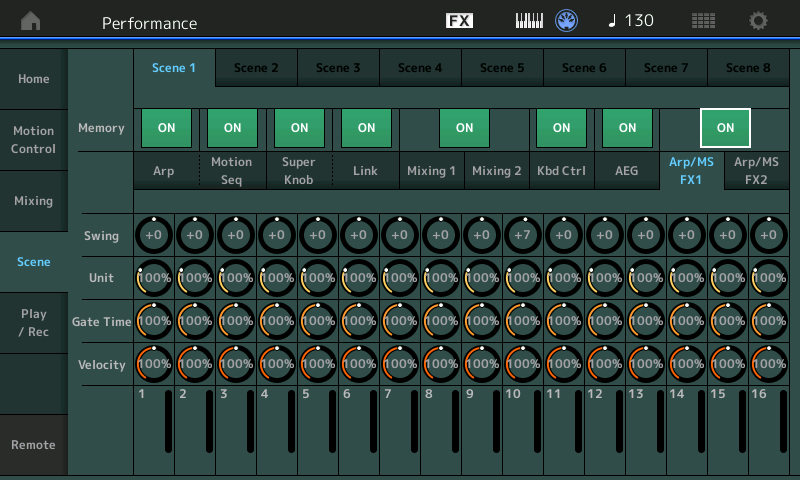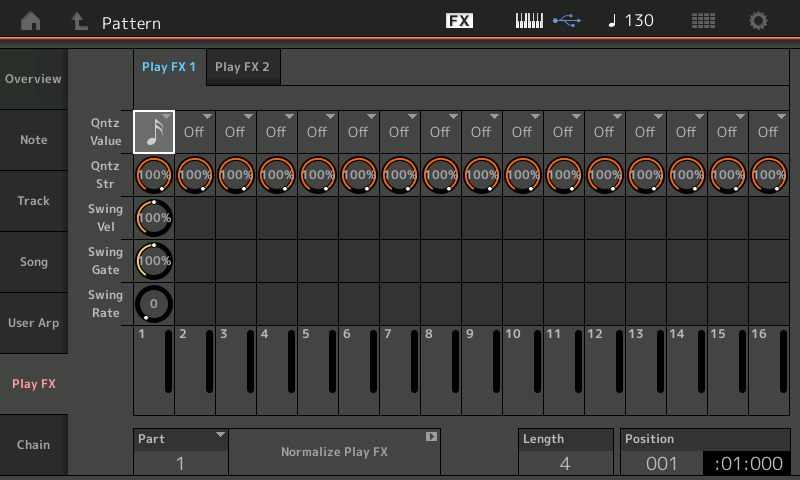Hi Guys. MODX7 question.
I understand that PLAY FX is supposed to allow you to adjust swing % and quantize and such for patterns. I assume that it allows this for preset patterns, and not just ones you create.
I can't get it to make changes to any existing patterns, so I must be doing something wrong. I can get within a performance to the screen that enters Play FX and get to the quantize and swing parameters, but nothing I tweak affects the pattern that's running at all. What am I (not) doing? Thanks.
By the way, MODX is an incredible machine, and now that I've gotten over a few humps, is pretty comfortable and intutive to get around, given that it does so much.
I appreciate your help in getting me to that stage!
Are you working with "existing patterns" or "existing arpeggios"? Patterns are new - and there is a different section for their play FX parameters vs arpeggios. This article is focused on arpeggios:
https://yamahasynth.com/learn/montage/montagifying-motif-smooth-it-over
... the part starting with:
Press the [PART SELECT 1] button
Press the [ARP/MS] button on the left front panel so we can view the 8 Rotary Encoder assignments in the screen (PART 1 ARP/MS):
This walks you through applying swing/etc. to arpeggios.
For patterns, this tutorial covers Play FX:
https://yamahasynth.com/learn/montage/pattern-play-fx-in-os-v3-0-mastering-montage
So first be sure you are adjusting the values that apply to which feature you're targeting (arpeggios or patterns).
Current Yamaha Synthesizers: Montage Classic 7, Motif XF6, S90XS, MO6, EX5R
“Arp/MS FX1/2” are the Play Effects that can be applied to the currently active Arpeggiator or Motion Sequence.
These are a separate thing from the Pattern Sequencer’s “Play FX1” and “Play FX2”
What a “Arp/MS Play Effect” does, is apply real-time offsets to the Arpeggio or Motion Sequence data — these offsets influence the ‘attitude and/or feel’ of the resulting ‘phrase’. You can think of it as a form of Quantize grid through which the phrases are passed — you’re shifting the data so it isn’t strict militaristic, straight-up-and-down Time... Swing, or what is loosely the ‘feel’, can be analyzed as having components of timing (where the event occurs), length (gate time/duration), impact (velocity/volume)...
You can find and apply these in two locations:
On the Part’s “Arpeggio” > “Common” screen
In the Scene Memory: [HOME] > “Scene” > you’ll find “Arp/MS FX1” and “Arp/MS FX2”
When this Memory Switch is On, you can apply the offsets.

What you hear is what will be documented were you to put a MIDI Track in Record. (Assuming Arp Rec is active).
In the PATTERN SEQUENCER you’ll find a similar set of offsets but these are applied to data that is already recorded to a Sequencer Track. Here you’ll find 2 screens “Play FX1” and Play FX2”

The goal is the same, to apply offsets to alter the feel and attitude of the recorded data... also included is things like Note Shift (interestingly enough, very useful when triggering different sound fx and/or audio loops). These offsets are initially non-destructive. This means you are filtering the data in real-time... allowing you to try-it-out... if you approve, you can *commit* to it by tapping “Normalize” — this rewrites the MIDI data on the Pattern Sequencer Track... and then “zeroes out” the Offset parameters.
Significantly the Pattern PLAY FX are applied after-the-fact... where the Arp/MS (Play) FX are applied to data as it is being generated.
In both cases committing to the offsets involves recording; writing data to the MIDI Track in the case of Arpeggio data, and recording your Performance as Audio in the case of the Motion Sequence.
We should mention, the nature of the Motion Sequence is that it is applied to the sounding Part. It does not get “recorded” as MIDI data — Motion Sequences are always applied live.
EXTRA CREDIT:
In addition to the articles referenced above by Jason, please see “Quantize: Before, Realtime, or After” and “The Power of Scenes”... links below
https://yamahasynth.com/learn/montage/mastering-montage-quantize-in-os-v3
https://yamahasynth.com/learn/montage/mastering-montage-scenes-in-os-v3
